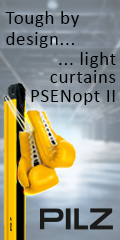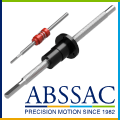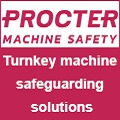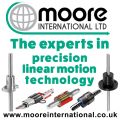
Posted to News on 28th Mar 2012, 18:15
Resolvers, optical encoders and inductive encoders
Resolvers are good. Encoders are good. But which is the best? Mark Howard of Zettlex examines the strengths and weaknesses of each and also offers some alternatives.
What is a Resolver?
A resolver is an electrical transformer used to measure angle of rotation. Most resolvers look rather like an electric motor - with copper windings on the stator and a machined metal rotor. The inductive coupling between the transformer's windings varies according to angle. So, if we energise the resolver with an AC signal and measure the output from the transformer's windings, we get an AC electrical signal whose amplitude is proportional to angle.
While there are lots of different types, a typical resolver has three windings - a primary winding and two secondary windings. These windings are made using copper wire and are usually formed on the resolver's stationary element - the stator. The primary winding is used as the input for an AC drive signal and each secondary is used as pick up or receive winding. The rotor can be made from a material such as iron or steel and is arranged such that it will couple varying amounts of energy into the secondaries depending on its angle of rotation. The output from the secondaries will be in the form of a sinusoid and cosinuoid. Accordingly, the ratio of signals varies in proportion to angle.
Resolvers have a solid reputation for reliability and are often the automatic choice for high-reliability and safety-related applications. A common pitfall is that many resolver data sheets specify infinite resolution. Whilst this is theoretically true, in practice, it is not: most modern control systems will be converted to a digital signal of finite resolution. The actual resolution will be determined by the quality of the analogue-to-digital conversion circuit.
This leads to a subtle but important point - namely that a fair amount of specialist skill is needed to engineer a resolver-based system. This is because a separate signal excitation and processing circuit is required. Resolvers also have a reputation for being heavy, bulky and expensive. They are not economically viable for many mainstream applications and, in general, are only used in those sectors where capital cost is secondary to specification and performance such as aerospace and defence.
- Strengths: Reliable, robust, accurate, long life, tolerant to misalignment
- Weaknesses: Bulky, heavy, expensive, needs skilful specification and implementation
What is an Optical Encoder?
A rotary encoder, also known as a shaft encoder, is a device that converts angular position or motion to an analogue or digital code. There are two main types: absolute and incremental (relative). The output of absolute encoders indicates the current position of the shaft, making them angle transducers. The output of incremental encoders provides information about the motion of the shaft, which is typically further processed elsewhere into information such as speed, distance, rpm and position.
Encoders can use a variety of sensing techniques, but the most common is optical. In optical encoders, a source shines light onto or through a rotating disk, which is marked such that the light passes through or is blocked. The optical sensor senses the light's passage and generates a corresponding electrical pulse. The optical scales can be arranged as a series of markings, which can be used to measure angle or motion. The scale of the markings can be very fine - down to microns.
Thirty years ago, most applications used resolvers rather than optical encoders. Nowadays, the situation is reversed. A major factor is that there are a myriad of different encoders available from a wide variety of manufacturers. Unlike resolvers, optical encoders do not require any separate electronics. Their output is immediately useable by a host control system. As such, they are easier to specify and deploy. Their major weakness is that they simply cannot cope with harsh environments that might feature vibration, shock, foreign matter or extreme temperatures. There is little or no warning of imminent failure.
- Strengths: High resolution, widely available, high accuracy possible
- Weaknesses: Delicate, susceptible to foreign matter, catastrophic failure modes, limited temperature range (-20 to +70degC)
What is an Inductive Encoder?
In recent years, a new generation of device has become popular - the inductive encoder. Inductive encoders can be thought of as a hybrid of a resolver and an optical encoder. Inductive encoders (or Incoders) use the same basic physics as a resolver but are less costly, lighter, more compact and more accurate. Importantly, they are also easier to use because they only require a DC supply and output a digital signal representing absolute angle - like an absolute optical encoder. The skills issue is eradicated because inductive encoders do not require separate electronics processing circuitry - all the necessary electronics are integrated in the inductive encoder's stator. This means that Incoders have all the advantages of resolvers but with none of their disadvantages.
Because inductive encoders do not use delicate optical components, they are not susceptible to foreign matter and do not only operate in limited temperature ranges. Indeed, in some instances they have been used at temperatures of up to 230degC.
Rather than the traditional resolver's copper wire windings, Incoders use printed circuit boards as their main components. As with a resolver, there is a stator and a rotor but because there is no requirement for precise location of the stator and rotor, there is no need for any bearings.
Since Incoders use printed circuit boards rather than wire windings, this means that they can offer extremely high accuracy. Accuracies of
Incoders are available in a wide range of sizes up to 600mm diameter and have been used extensively in a variety of machine tools, gimbal systems, aerospace, defence and medical equipment.
- Strengths: High resolution, accurate, reliable, robust, long life, tolerant to misalignment
- Weaknesses: Temperature range is greater than optical but not as great as resolvers
For more information on new generation inductive position sensors, please contact Zettlex UK Ltd on 01223 874 444 or visit the website at www.zettlex.com, or email [email protected].

































